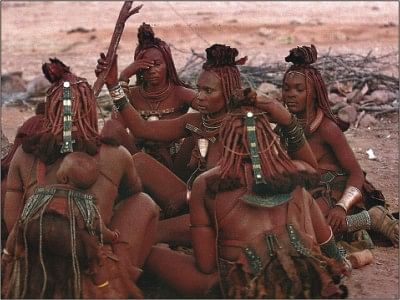Go Yamagata: Visions of wild Africa

Himba women exchange notes about village issues.
From the regal Himbas, a semi-nomadic pastoralist tribe, to the majestic lion and other unusual animals, to matchless landscapes. All these images from Southern Africa have been captured on camera by Japanese photographer Go Yamagata. And for a change, instead of dwelling on the poverty stricken Africa, Yamagata has managed to give a refreshing perspective of the continent. “Through my exhibition, I convey the beauty, diversity and power of wild Africa,” says the young photographer.
One ventures into the India International Centre, New Delhi to be immediately greeted by photographs of Himba tribals. One work is titled “Little girl and her brother” (Kaokoland, Namibia) and another “Woman collecting milk” (Epupa Falls, Namibia).
A work that immediately catches attention is of a group of Himba women engaged in what looks like a serious discussion, perhaps exchanging notes about village affairs. Turned up in traditional attire and jewellery, the topless women are engaging with their plaited hair and sheepskin skirts. “One of the reasons I chose the Himbas in my works is that they have managed to preserve their traditional lifestyle, without much western influence,” explains Yamagata.
The Kalahari desert is also a recurring theme. Take, for instance, “Dawn over the Savannah” (from Central Kalahari Game Reserve, Botswana). This landscape captures the beauty of the rainy season when the arid desert becomes a land of lush green pasture.
When one comes to the third and last section of the exhibition, one cannot but help marvel at Yamagata's mastery over his medium. Here, in addition to the staple of lions, giraffes, hippos and zebras, there are photographs of rare and fascinating fauna: The elephant shrew, small, insectivorous mammals which are akin to mice. Also on display are jacana, a group of tropical waders, carmine bee eaters and the oryx, one of three to four large antelope species.
Does Yamagata have many interesting encounters along the way? Yes, he says, pointing to a work called The Angry Hippo. Shot in Mamili National Park, Namibia, after the shoot was over, he saw a hippo charging at him. Describing this as “the scariest moment” of his life, Yamagata obviously had to run for his life. Talking about the dangers of the wilds of Africa, he says that, “Hippos kill more people than lions or leopards. In fact, hippos and crocodiles are probably the most dangerous animals in the African bush.”
Yamagata has also captured unusual facets of wildlife such as a standing elephant in the deserts of Namibia. Here we get to see an elephant on its hind legs as it seeks to reach the branches of an elusive tree.
Yamagata now plans to go back to Africa in June/July and is likely to return to India in August. The photo exhibition of sanctuaries in Central India, which Yamagata plans to launch will be held within the next two years. This exhibit goes in conjunction with the art works of his scientist father, Yoichi Yamagata, also currently in India.

 For all latest news, follow The Daily Star's Google News channel.
For all latest news, follow The Daily Star's Google News channel. 



Comments